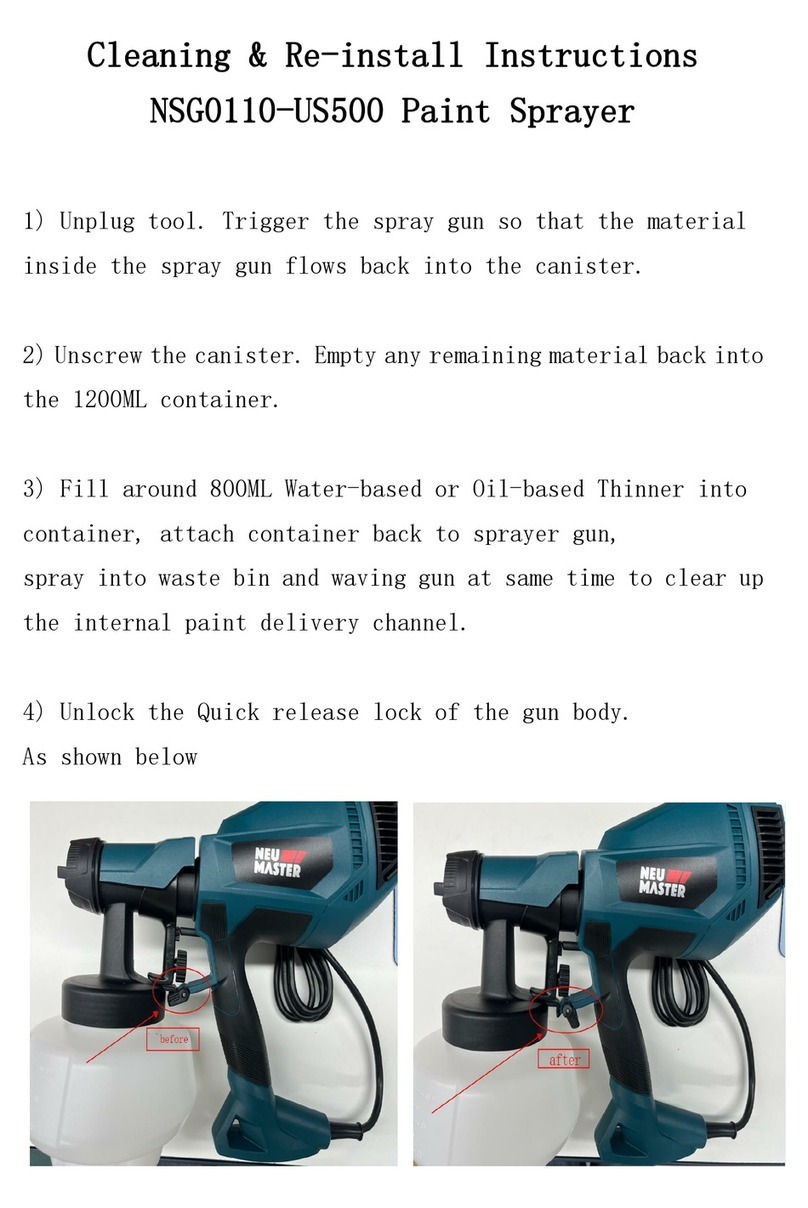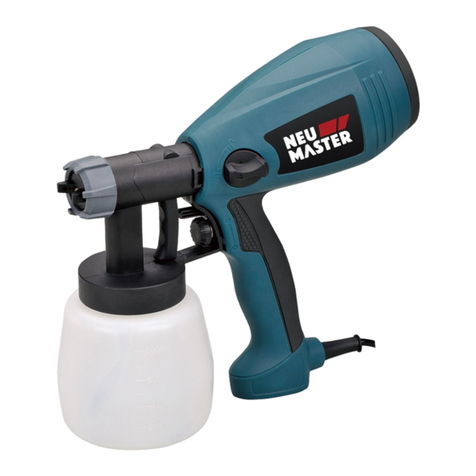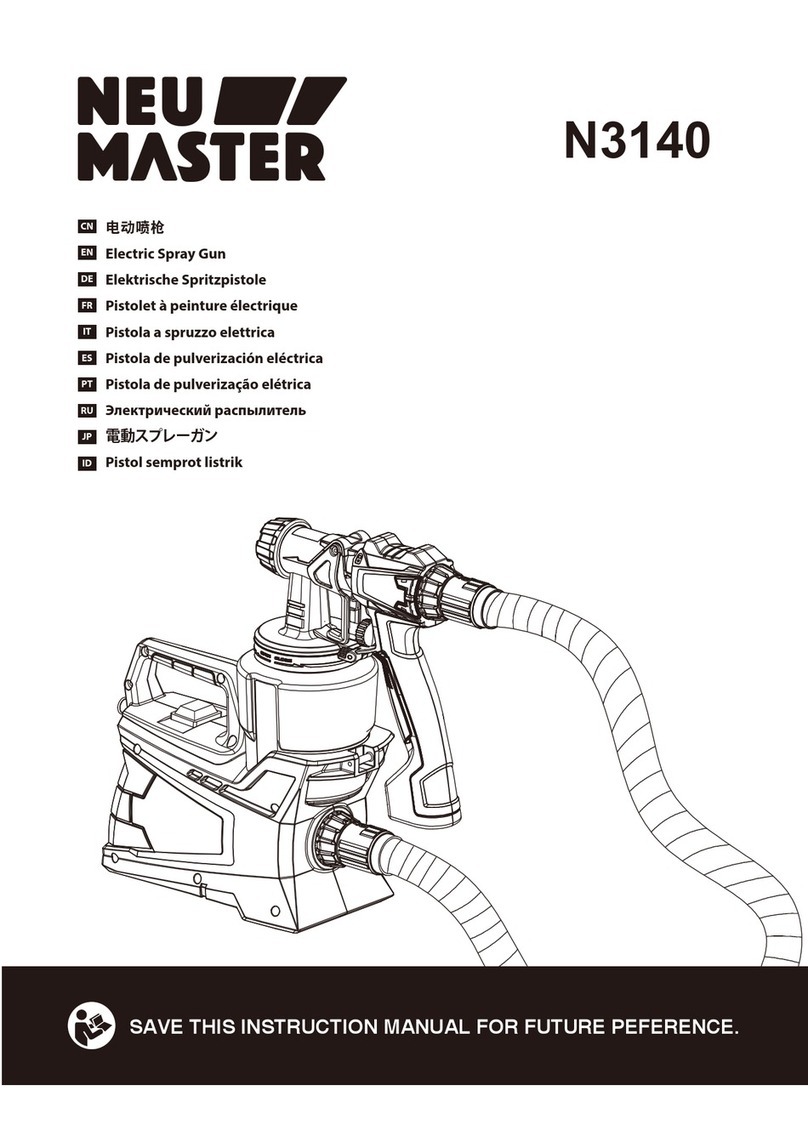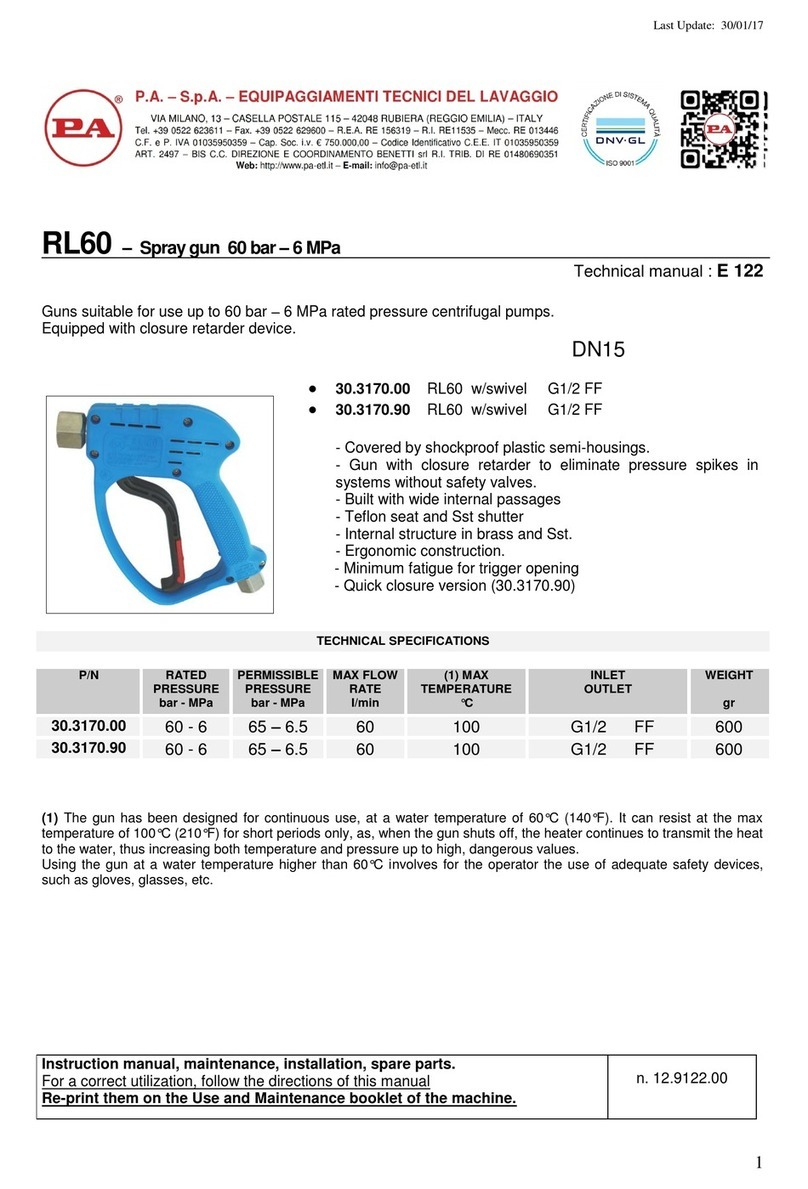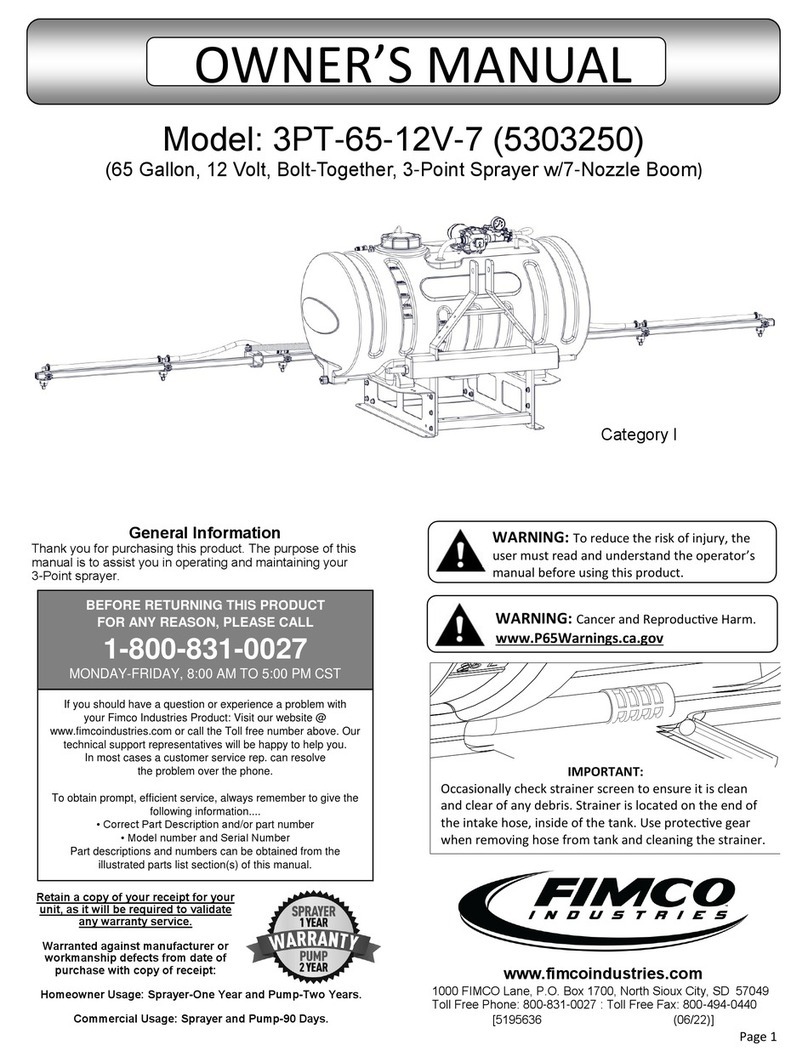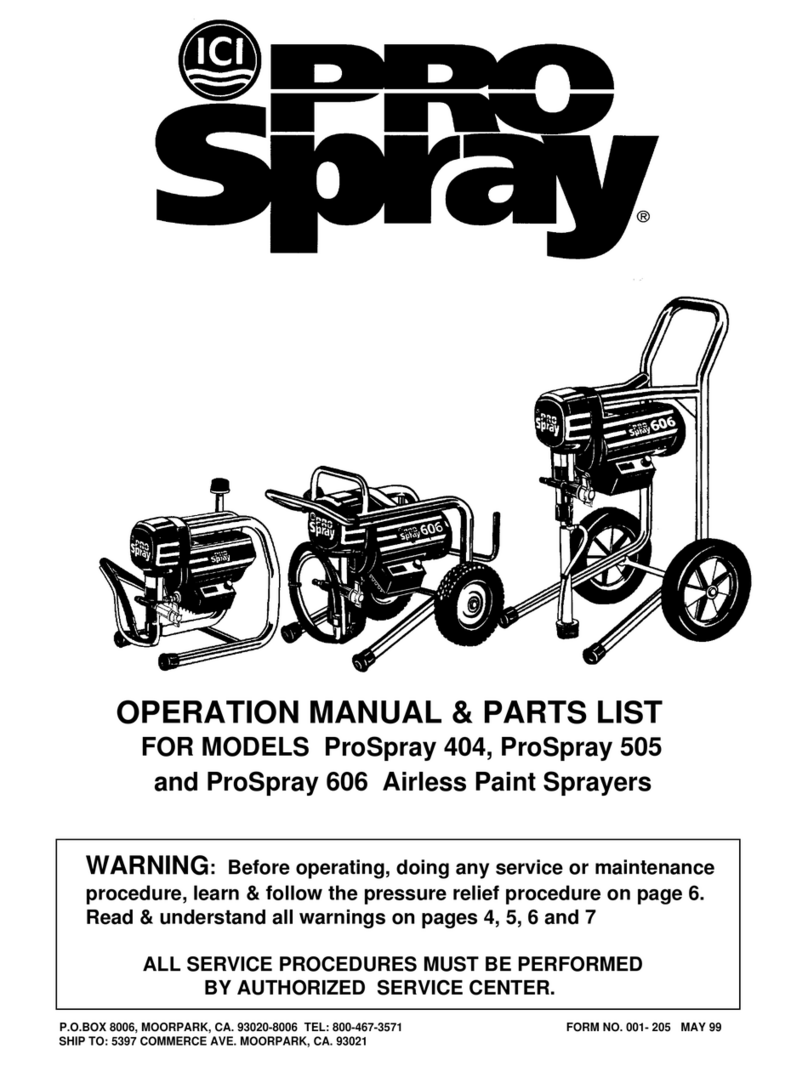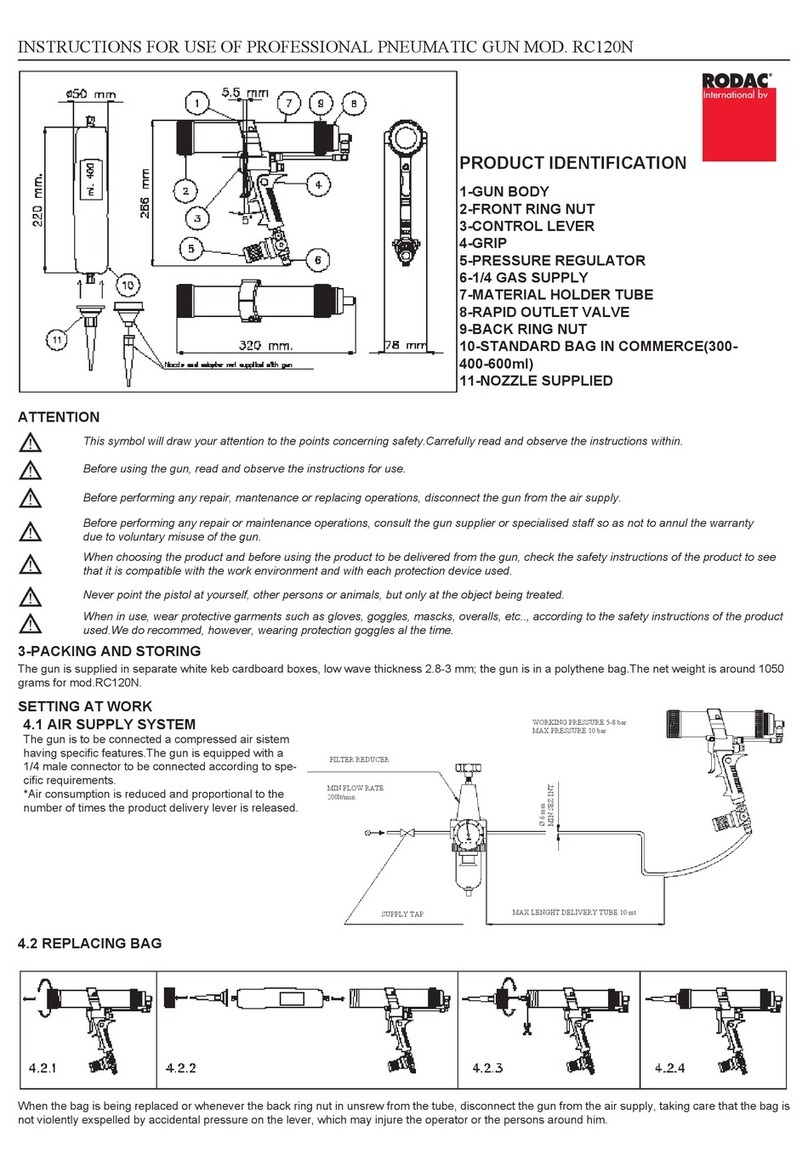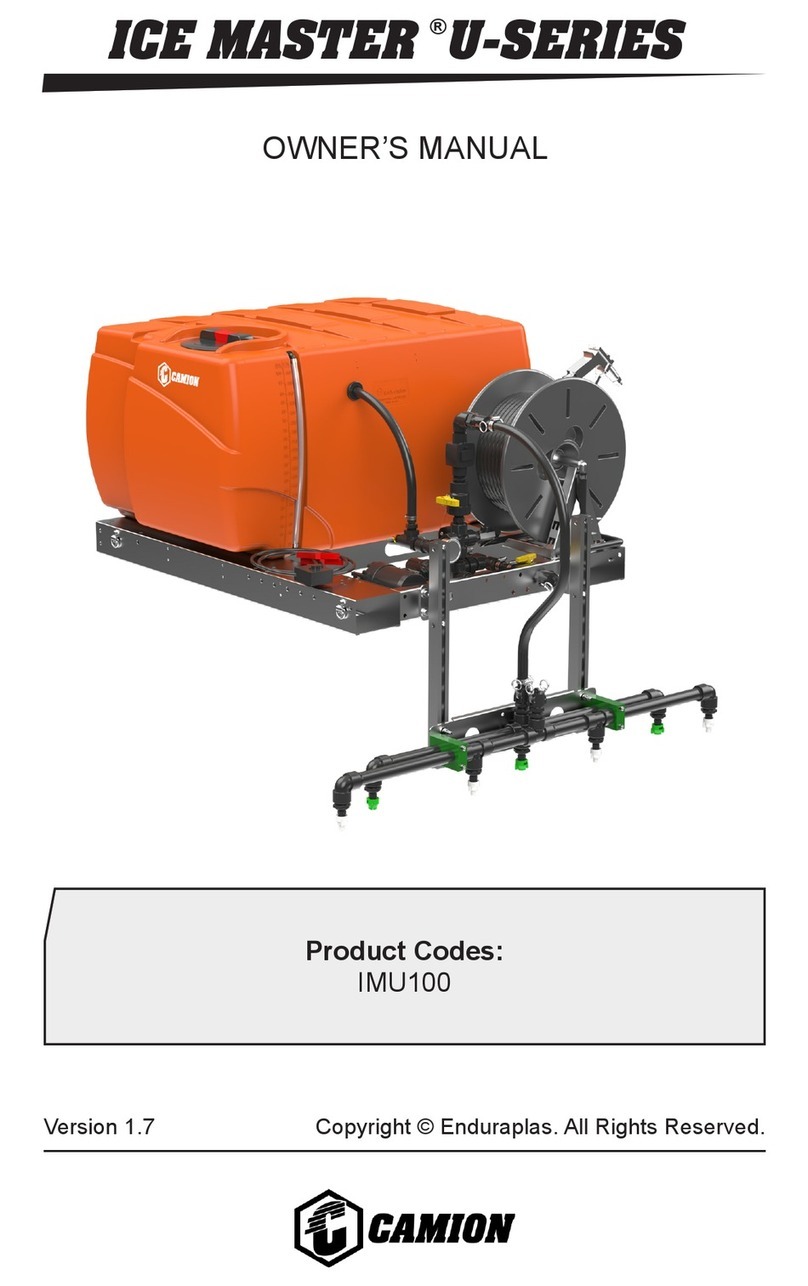NEU MASTER NSG0070-US500 User manual

INSTRUCTIONS MANUAL
Electric Spray Gun
NSG0070-US500
WARNING: READ INSTRUCTIONS MANUAL BEFORE USING PRODUCT.

FIG. A

FIG. A1
FIG. A2

FIG. B
FIG. C
FIG. D

FIG. F
FIG. E FIG. E1

FIG. G
FIG. H FIG. H1
FIG. I

FIG. J
FIG. K
FIG. L
50 to 300mm

FIG. M
FIG. N
FIG. O
FIG. P

FIG. Q
FIG. R
FIG. Q1
FIG. S
27
90°
9

FIG. T
FIG. T1
FIG. U1

ENGLISH ENGLISH
noitcurtsniehtdnatsrednudnadaeR
manual.
Fire hazard.
Explosion hazard.
Respiratory hazard.
Electric shock hazard.
SAVE THESE INSTRUCTIONS:
To reduce the
risks of fire or explosion, electrical shock and
the injury to persons, read and understand all
instructions included in this manual. Be familiar
with the controls and the proper usage of the
equipment.
To avoid these risks, take the following
preventions:
►Exhaust and fresh air introduction must be
provided to keep the air within the spray area
►Avoid all ignition sources such as static
electricity sparks, open flames, pilot lights, hot
objects, lit tobacco products, and sparks from
connecting and disconnecting power cords or
working light switches.
►Fire extinguisher equipment shall be present
and working.
►Keep area clean and free of paint or solvent
►Follow the material and solvent manufacturer’s
safety precautions and warnings.
►Do not spray flammable or combustible
materials near an open flame or sources of
ignition such as lit tobacco products, motors, and
electrical equipment.
►Know the contents of the spray materials
and their cleaning solvents. Read all Material
Safety Data Sheets (MSDS) and container
labels provided with the spray materials and
solvents. Follow the spray material and solvent
manufacturer’s safety instructions.
than 60ºC (140ºF). Flashpoint is the temperature
(see coating supplies).
Wa rning! Ex p losion ha z ard due to
incompatible materials. Severe injury or
property damage can occur.
To avoid these risks, take the following
preventions:
► Do not use bleach.
►Do not use halogen a ted hydrocarb o n
solvents such as methylene chloride and 1,1,1
- trichloroethane. They are not compatible with
aluminum and may cause an explosion. If you
are unsure of a material’s compatibility with
aluminum, contact your coating supplier.
Warning! Hazardous vapors.
yarpS
slairetamrehtodna,stnevlos,slairetam
niemocrodelahnifilufmrahebnac
contact with the body. Vapors can cause
severe nausea, fainting, or poisoning.
To avoid these risks, take the following
preventions:
► Use a respirator or mask if vapors can be
inhaled.
Read all instructions supplied with the mask to
be sure it will provide the necessary protection.
► Wear protective eyewear.
► Wear protective clothing as required by
coating manufacturer.
Warning! Electric shock hazard. May
cause severe injury.
To avoid these risks, take the following
preventions
►Keep electrical cord plug and sprayer trigger
free from spray material and other liquids. Never
hold cord at plug connections to support cord.
Failure to observe may result in an electrical
shock.
►Never immerse electrical parts in water or any
other liquid. Wipe the exterior of the sprayer with
a damp cloth for cleaning. Always make sure the
sprayer is unplugged before taking it apart for
cleaning.
► Do not expose unit to rain or wet conditions.
►Do not abuse the cord. Never use the cord to
carry the unit or pull the plug from an outlet. Keep
cord away from heat, oil, sharp edges or moving
parts. Replace damaged cords immediately.
Warning! General. To Reduce the risk of
severe injury or property damage.
To avoid these risks, take the following
preventions:
►Do not aim the gun at, or spray any person,
including self, or animal.
► Do not spray outdoors on windy days
►Wear protective clothing to keep spray
material off skin and hair.
► Hose may become hot and cause skin burn.
► Follow all appropriate local, state, and national
operation.
►Always use appropriate gloves, eye protection
and a respirator or mask when spraying, thinning,
mixing, pouring, or cleaning.
►Do not operate or spray near children. Keep
children away from equipment at all times. Keep
sprayer out of the reach of children.
►Do not overreach or stand on an unstable
support. Keep effective footing and balance at all
times.
► Stay alert and watch what you are doing.
It is important for you to read and understand this
manual. The information it contains relates to
protecting YOUR SAFETY and PREVENTING
PROBLEMS. The symbols below are used to
help you recognize this information.
Danger! Indicates an imminently hazardous
situation which, if not avoided, will result in death
or serious injury.
Warning! Indicates a potentially hazardous
situation which, if not avoided, could result in
death or serious injury.
Caution! Indicates a potentially hazardous
situation which, if not avoided, may result in
minor or moderate injury.
Notice! Used without the safety alert symbol
indicates a potentially hazardous situation which,
if not avoided, may result in property damage.
The following are explanations of important
safety hazard pictorials in this manual.
TECHNICAL DATA
IMPORTANT SAFETY INSTRUCTIONS
SAFETY GUIDELINES - DEFINITIONS GENERAL SAFETY WARNINGS
Rated Current 4.0A
Water Flow Rate 900ml/min
Max. Viscosity 100 DIN-s
(runout time: 100seconds)
Nozzle Size
Φ2.5mm /
Φ2.0mm /
Φ3.0mm
Canister Capacity 1200ml
►
This product is intended for household use only.
Warning! Fire or explosion
hazard. Solvent and spray material fumes can
explode or ignite. Severe injury or property
damage can occur.

lock (#19) and snap onto the hook on the edge of
Cleaning brush
Switch trigger lever
Spray gun unit
ENGLISH ENGLISH
►Do not operate the unit when fatigued or
►Read all instructions and safety precautions
fo r equ ipment and s pray ma t eria l b efore
operating any equipment.
►Hearing protection is recommended for
extended use.
Warning! Some spray materials contain
chemicals known to the State of California to
cause cancer, birth defects or other reproductive
harm. To reduce your exposure wear appropriate
safety equipment such as face masks, gloves,
and other appropriate protective equipment.
Please review and follow the safety precautions
on the paint container.
FEATURES (Fig. A, Fig. A1, Fig. A2 )
1.
2. Power unit
3. Smart nozzle selector
4. Tip collar
5. Air cap
6. Nozzle (Φ2.0mm/Φ2.5mm/Φ3.0mm)
7. Y-type seal ring
8. Spray width lever
9. Spray tip
10. Spray unit housing
11. Trigger
12.
13. Sealing linear
14. O-ring
15. Pickup tube
16. Check valve assembly
16.1 Check valve sleeve 1
16.2 Check valve
16.3 Spring
16.4 Check valve sleeve 2
16.5 Valve extension
17. Canister
18.
Flow control knob
19. Quick release lock
20.
21.
22.
Filter
23.
Filter cover
24.
Viscosity cup
25.
Cleaning needle
26. Spray tip key
Warning! Be sure to use appropriate
protective gear and unplug unit.
Warning! Make sure area is well ventilated
Aligning the pickup tube (Fig. B)
The pickup tube (#15) needs to be aligned in the
direction toward the front of the canister ( Fig. B).
This will ensure you spray as much material as
Make sure the pickup tube is assembled tight
in place.
Attaching spray unit to the handle ofgun
Align the marking line on the spray unit with the
icon of unlock, then rotate the spray gun handle
anticlockwise until stop. Rotate the quick release
canister lid.
Liquid material preparation (Fig. E1 and E2)
Tip: Make sure the type of material you use can
be cleaned with either mineral spirits or paint
thinner (for oil-based paints) or a warm water
and soap solution (for water soluble paints like
latex). Use rag during pouring , mixing , and
testing of materials to be sprayed to
portect your floors and anything else in the
ying area that you wish to remain untouched
ebotdeenyamdey
arpsgniebdiuqilehT
thinned (diluted) before starting. When
thinning, use the proper liquid thinner
recommended on the container by the material
manufacturer..
Warning!: Do not use materials with a
A viscosity test cup is provided to determine the
“runout time” of the material being used.
►Before measuring for the proper viscosity, stir
the material thoroughly.
►Dip the viscosity cup into the material being
►With the cup held over the material container,
measure the amount of time it takes for the
being a constant stream out of the bottom of
the cup (100 seconds or less) . This is
the “runout time”. Refer to the thinning table for
information on the thinning required for different
materials.
►If material needs thinning, add the appropriate
liquid, thinning material recommended by the
manufacturer
►It is possible to spray latex paint with this
unit, however, the required thinning may exceed
material manufacturer’s recommendation. Thin
latex paint so that it runs through viscosity cup
within100 seconds. The operator should consider
the type of application and final location of the
ELECTRICAL SAFETY
SET - UP
EXTENSION CORD
Type of
cable
Up to 5
metres
from 5 to
10 metres
Paralel 2x 1.0 mm22x 1.5 mm2
onerofereht;detalusnielbuodsilootsihT
earth wire is required. Always check that the
power supply corresponds to the voltage on the
rating plate.
tsumti,degamadsidrocylppusehtfI►
be replaced by the manufacturer or an authorised
Service Centre in order to avoid a hazard.
►When using the tool outdoors, only use
extension cables intended for outdoor use. A
suitable rated extension cable of up to 30 M can
be used without loss of power.
►Electric safety can be further improved by
using a high sensitivity.
(Fig. E)
(Fig. E1).
Use only a 3-blade grounding plug and a
3-slot receptacle that will accept the plug on the
product. Make sure your extension cord is in good
condition. When using an extension cord, be sure
to use one heavy enough to carry the current your
product will draw. An undersized cord will cause a
drop in line voltage resulting in loss of power and
overheating. If an extension cord is to be used
after the cord type designation. For example, a
designation of SJTW-A would indicate that the
cord would be appropriate for outdoor use. For
proper size cords see chart.
Guide for extension cord usage:
project when spraying a material that requires
more than 100 seconds to run through the
viscosity cup.
power unit C)(Fig.
viscosity

the tool.
ffonrutotreggirtehtesaeleR.lootehtnonrutot)02#(
the switch inside the tool by the switch trigger lever
Squeeze to press the trigger (#11), trigger will actuate
(More than
(Less than
ENGLISH ENGLISH
FILLING THE CANISTER (FIG. F)
►Check to make sure that the canister is
completely screwed onto the sprayer.
►Stand the sprayer firmly on a smooth and
horizontal surface
►Pour the properly thinned and strained
material to be sprayed into the canister (Fig. F).
►Clean any residual liquid from the threads or
sides of the canister and sprayer.
►Starting the threads evenly, screw the lid
completely onto the top of canister. Check the
lid to make sure it is threaded on squarely and
completely before picking up the sprayer.
ON / OFF SWITCH (Fig. G)
SMART SELECT NOZZLE SELECTION (Fig. H,
Fig. H1)
There are three spray patterns to choose from:
- Vertical Flat Jet
- Horizontal Flat Jet
- Circular Jet
To select Vertical Flat Jet , turn
the air cap (#5) to horizontal
direction by turning the smart
nozzle selector (#3) clockwise
until stop.
To select Horizontal Flat Jet,
turn the air cap(#5) to vertical
direction by turning the smart
n o z z l e s e l e c t o r ( # 3 ) a n t i -
clockwise until stop.
To select Circular
Jet, turn the Spray
Width Lever (#8)
t o t h e i c o n o f
Minimum.
Note: Spray nozzle can only be assembled in
one direction that the notch of the nozzle(#6)
m u s t ali g n w i t h t h e s k i r t o n s p r a y u n i t
housing(#10). Refer to Fig. T1 for proper
assembly.
Warning! Risk of injury. Never point the
sprayer at any part of the body. Never pull the
trigger while adjusting the spray setting.
ADJUSTING WIDTH OF SPRAY PATTERN (Fig.
H1)
By turning the Spray Width Lever (#8) between
the Minimum marking and Maximum marking,
the width of the spray patterns can be adjusted
accordingly.
PREPARATION TIPS
►Always stir and strain the material thoroughly
before use.
►With any spraying job you should always
ensure that you have properly prepared the
are free from dust, dirt, rust and grease. Lightly
pressure wash decks or exterior surfaces and
ensure that they are dry before spraying.
►Even though HVLP sprayers have very little
overspray, it is recommended that you mask
all edges and other areas and use drop cloths
to protect your floors and anything else in the
spraying area that you wish to remain untouched.
► Skin that forms on the top of paint can clog the
sprayer. Remove skin before mixing. Strain with
to remove any impurities that could clog system.
►Before starting have gloves, paper towels,
rags etc. available for unexpected spills.
OPERATION
THINNING TABLE
SPRAY MATERIAL RUNOUT TIME
Clear and semi-
transparent
stains and sealers
Oil based primers,
varnishes and
polyurethane
No thinning required
seconds runout)
Solid color water
based stains
Water based or
latex paints
May require thinning
seconds runout)
Note: Not recommended for textured paint
Vertical narrow jet for
horizontal coating
direction
Horizontal narrow jet
for vertical coatiang
direction
Vertical wide jet for
horizontal coating
direction
Horizontal wide jet
for vertical coating
direction
Small-medium
size surface
Large size
surface top
coating
Initial coatings,
corners, edges,
and hard to reach
locations
Small circular jet
Application Spray Width Lever #8 Air Cap #5 Spray Jet Pattern
100
100
2

ENGLISH ENGLISH
FLOW CONTROL KNOB (Fig. I)
The flow control knob(#18) regul ates t he
amount of liquid that can be sprayed. Turning
the flow knob clockwise increases the flow of
liquid. Turning the knob counter anti-clockwise
Tip: Always test the spray pattern on scrap
control knob on the highest flow setting. If less
flow is desired, dial the flow control knob anti-
thicker materials should be sprayed with the
flow control knob on high flow setting. Thinner
►Practice spraying on a piece of scrap material
such as cardboard to test your spray pattern and
become familiar with the flow control feature of
the sprayer.
►Ensure surface to be sprayed is free of dust,
dirt, and grease.
►Ensure spray area is clean and free of dust
that could be blown onto newly sprayed surfaces.
► Cover any areas not intended to be sprayed.
►Always spray from a minimum of 50mm to a
maximum of 300mm (Fig. J).
►A commonly used method for spraying a large
surface is the “crisscross” pattern. This is done
by spraying in horizontal strips and then crossing
over these strips with vertical strips (Fig. L).
►To get an even spray distribution, always keep
your arm at the same distance (Fig. J) from the
surface you are spraying and avoid moving your
wrist (Fig. K).
►Maintain smooth and consistent speed which
will help avoid inconsistencies. Begin spraying
after the pass has begun and release trigger
before stopping the pass.
►Avoid spraying too heavily in any one area.
Several lighter coats are better than one heavy
coat which can lead to running and dripping.
Remember that the flow control knob regulates
the amount of liquid that can be sprayed. Turning
the flow knob clockwise increases the flow
of liquid. Turning the knob counterclockwise
decreases the flow of liquid. If runs or drips do
occur, have a dry paint brush on hand to smooth
them out.
►Turn the power unit off and place the sprayer
in the built-in dock of the power unit when not
spraying for any length of time.
cleaning solution.
cleaning solution (Fig. M). Screw on the canister
back the sprayer.
►Plug in the cord and turn on the power unit.
►Spray the cleaning solution through the
sprayer onto scrap material for 2 to 3 seconds
(Fig. O).
►Turn the power unit off, unplug the cord.
► Unscrew the canister from the sprayer.
►Remove the o-ring(#14), pickup tube(#15),
check valve (#16), and quick refill lid(#12) from
the sprayer. Clean the parts with the cleaning
brush in the appropriate cleaning solution (Fig. P).
Note: When removing the check valve, twist the
check valve clockwise and then pull it out.(Fig P
insert)
►Unscrew the tip collar (#4) and remove all
the parts of the spray nozzle(#3,#4,#5,#6,#7.#8)
from the sprayer.
Remove the spray tip(#9) from the sprayer ( Fig.
Q1). Clean all parts with the cleaning brush in the
appropriate cleaning solution (Fig. Q, Fig.Q1).
Be sure to clean around check valve with brush
(Fig. Q insert).
►If using water based material, clean the
sprayer by running water through pickup tube
inlet as shown in Fig. R. If using oil based
materials, clean pickup tube inlet with the
appropriate cleaning solution.
Repeat until sprayer is completely clean.
► Dry all parts thoroughly.
► Properly dispose of cleaning solution.
►Place a drop of household oil into the inside
of the sprayer from the hole for assembling the
spray tip (Fig. S).
► Reassemble sprayer (Fig. T).
Note: Spray nozzle can only be assembled in
one direction that the notch of the nozzle(#6)
m u s t alig n w i t h t h e s k i r t o n s p r a y u n i t
housing(#10). Refer to Fig. T1 for proper
assembly.
Note: The spray tip must be assembled in
the sprayer with the bumps on the spray tip in
vertical direction
Note: Assemble the pickup tube(#15) and check
on the sprayer.
►Wrap the air hose around the power unit and
put all accessories back into place.
Use only mild soap and damp cloth to clean the
power unit. Never let any liquid get inside the
power unit; never immerse any part of the power
unit into a liquid.
Important! To assure product SAFETY
and RELIABILITY, repairs, maintenance and
adjustment (other than those listed in this
manual) should be performed by authorized
service centers or other qualified service
personnel, always using identical replacement
parts.
by pulling the
bottom side of the filter cover (#22) and remebe it.
Remove the filter as shown in Fig.U1 and
Important! Never operate the power unit
in and interfere with the function of the power
unit.
Warning! Be sure to use appropriate
protective gear.
►Do not use materials with a flashpoint
higher than 60°C( 140°F) . Flashpoint is the
temperature that a fluid can produce enough
vapors to ignite (see coating supplier).
►Make sure clean up area is well ventilated and
►Always s pray o utdoor s whe n sp rayi ng
cleaning solution through sprayer.
► Do not submerse power unit.
►Use drop cloths during pouring, mixing, and
viscosity testing of materials to be sprayed to
protect your floors and anything else in the
spraying area that you wish to remain untouched.
►To begin cleaning:
►Turn the power unit off, unplug the cord.
►Unscrew the canister from the sprayer and
pour any remaining liquid back into the original
container (Fig. M).
►Pour a small amount of the appropriate
cleaning solution into the canister (Fig. N).
- Warm soapy water for water based materials
- Manufacturers recommended cleaning solution
for oil based materials
►Screw on the canister back to the sprayer
securely and vigorously shake the sprayer.
►Unscrew the canister and properly dispose of
DEVELOPING THE PROPER
SPRAYING TECHNIQUE
CLEANING
MAINTENANCE

ENGLISH ENGLISH
PROTECTING THE ENVIRONMENT
STORAGE TROUBLESHOOTING
ACCESSORIES
Make sure unit is clean and dry before storing.
Store unit indoors in a dry location. To prevent
damage, wrap the electrical cord so that it is not
crimped during storage.
Recommended accessories for use with your
product are available from your local dealer or
authorized service center.
Warning! The use of any accessory not
recommended for use with this product could be
hazardous.
Separate collection. This product must
not be dispos e d o f with nor m a l
day
that
your
product
needs
replacement, or if it is of no further use to you, do
not dispose of it with household waste. Make this
product available for separate collection.
Separate collection of used products
and packaging allows materials to be
recycled and used again. Re-use of
recycled materials helps prevent environmental
pollution and reduces the demand for raw
materials. Local regulations may provide for
separate collection of electrical products from
the household, at municipal waste sites or by the
retailer when you purchase a new product.
TROUBLE! MATERIAL RUNS OR DRIPS.
WHAT’S WRONG? WHAT TO DO…
Spraying too much material. knob.
Spraying too slowly. Increase speed of application.
Spraying too close. Increase distance from surface.
Viscosity too thin. Check dilution recommendation.
TROUBLE! MATERIAL DRIPS FROM NOZZLE
WHAT’S WRONG? WHAT TO DO…
Nozzle loose Screw nozzle tight
Nozzle breaks Change
Y-type seal ring of nozzle breaks Change
Material accumulated /clog inside nozzle Clean
TROUBLE! TOO MUCH OVER SPRAY.
WHAT’S WRONG? WHAT TO DO…
Sprayer too far from surface. Reduce distance to surface.
Too much material being sprayed.
TROUBLE! LITTLE OR NO MATERIAL BEING RELEASED.
WHAT’S WRONG? WHAT TO DO…
Spray nozzle/tip clogged. Clean nozzles.
Y-type seal ring of nozzle missing Add seal ring to nozzle and assemble in place
Pickup tube loose or clogged. Check tube.
Canister loose Screw canister tightly in place
Flow control knob setting too low.
Air inlet blocked
Material too thick. Thin material per manufacturer recommendation.

TROUBLE! MATERIAL BEING SPRAYED IS SPLATTERING
WHAT’S WRONG? WHAT TO DO…
Viscosity of material is too high. Thin material per manufacturer recommendation.
TROUBLE! ATOMIZATION IS TOO COARSE
WHAT’S WRONG? WHAT TO DO…
Viscosity of material too high. Thin material per manufacturer recommendation.
Flow control knob setting too high Decrease ow control setting
Material accumulated /clog inside nozzle Clean
Air inlet blocked Clean or change air lter
Canister loose Screw canister tightly in place
Quick rell lid loose Screw quick rell lid tight in place
TROUBLE! SPRAYER PULSATES.
WHAT’S WRONG? WHAT TO DO…
Air lter clogged Clean or change air lter
Material in canister almost empty. Rell canister.
Canister loose Screw canister tightly in place
Quick rell lid loose Screw quick rell lid tight in place
TROUBLE! SPRAY MATERIAL DOES NOT COVER PROPERLY
WHAT’S WRONG? WHAT TO DO…
Flow control knob setting too low. Increase ow control setting
Clearance to target area too large Reduce spray distance
Too few spray paths sprayed over target area Apply more spray paths sprayed over target area
Viscosity of material too high. Thin material per manufacturer recommendation.
ENGLISH ENGLISH
Table of contents
Other NEU MASTER Paint Sprayer manuals
Popular Paint Sprayer manuals by other brands
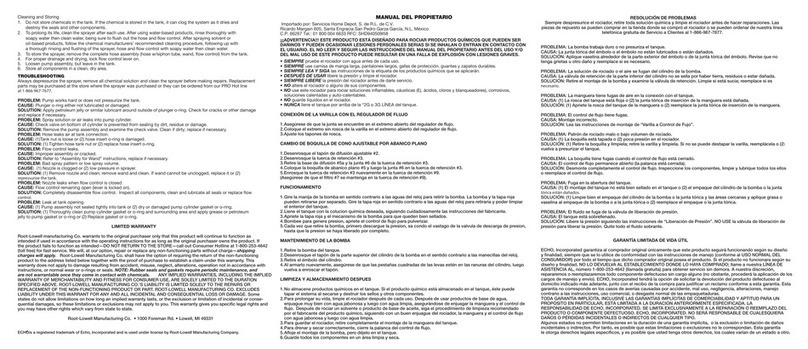
Echo
Echo MS-300 Operator's manual
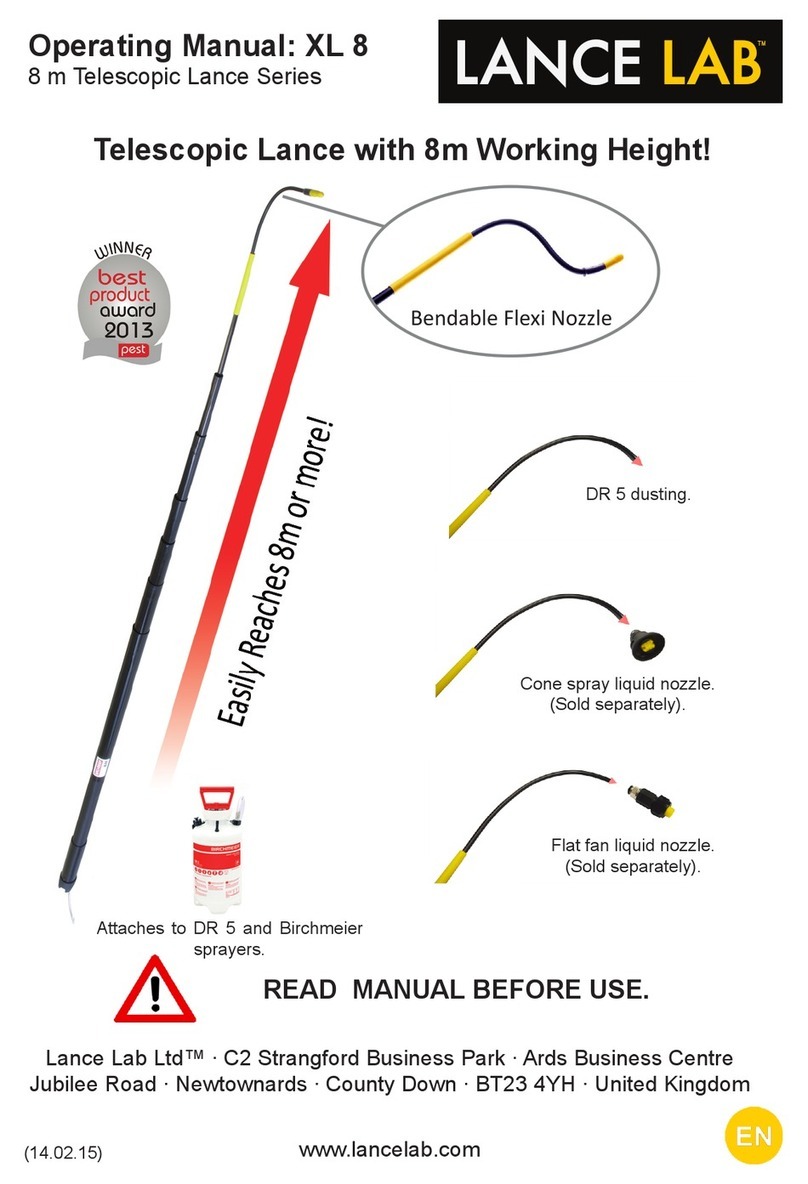
Lance Lab
Lance Lab 8 m Telescopic Lance Series operating manual

BE Ag & Industrial
BE Ag & Industrial AGRI EASE 90.700.100 Operations & parts manual
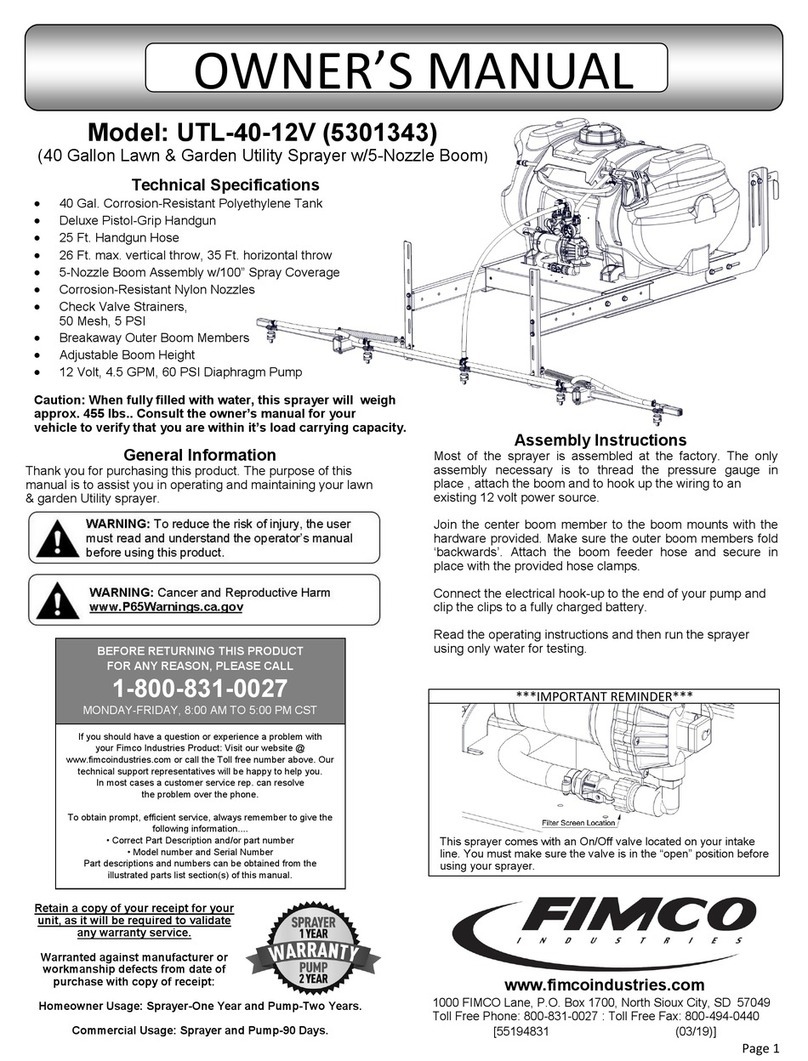
Fimco
Fimco UTL-40-12V owner's manual

swissmex
swissmex 547195 Operator's manual

Fimco
Fimco LG-3025 Assembly and operation instructions
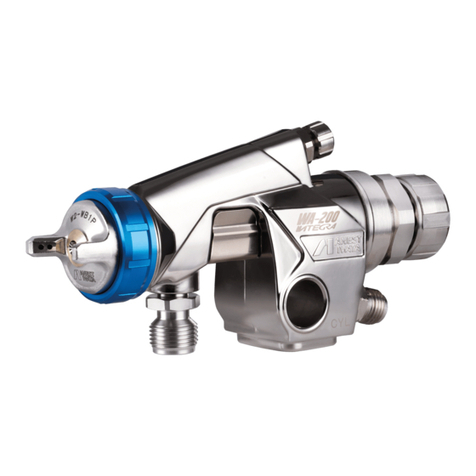
Anest Iwata
Anest Iwata WA 200 Installation, use & maintenance instruction manual
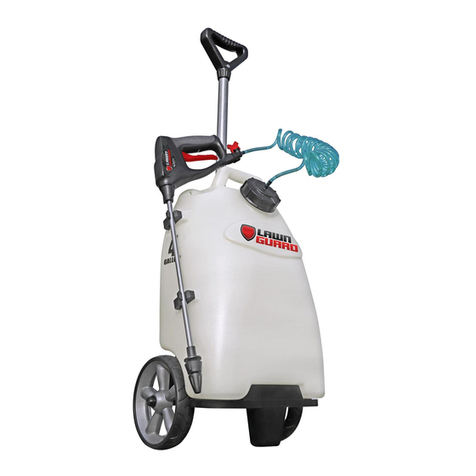
Fimco
Fimco LAWN GUARD LWN-GRD-4 owner's manual
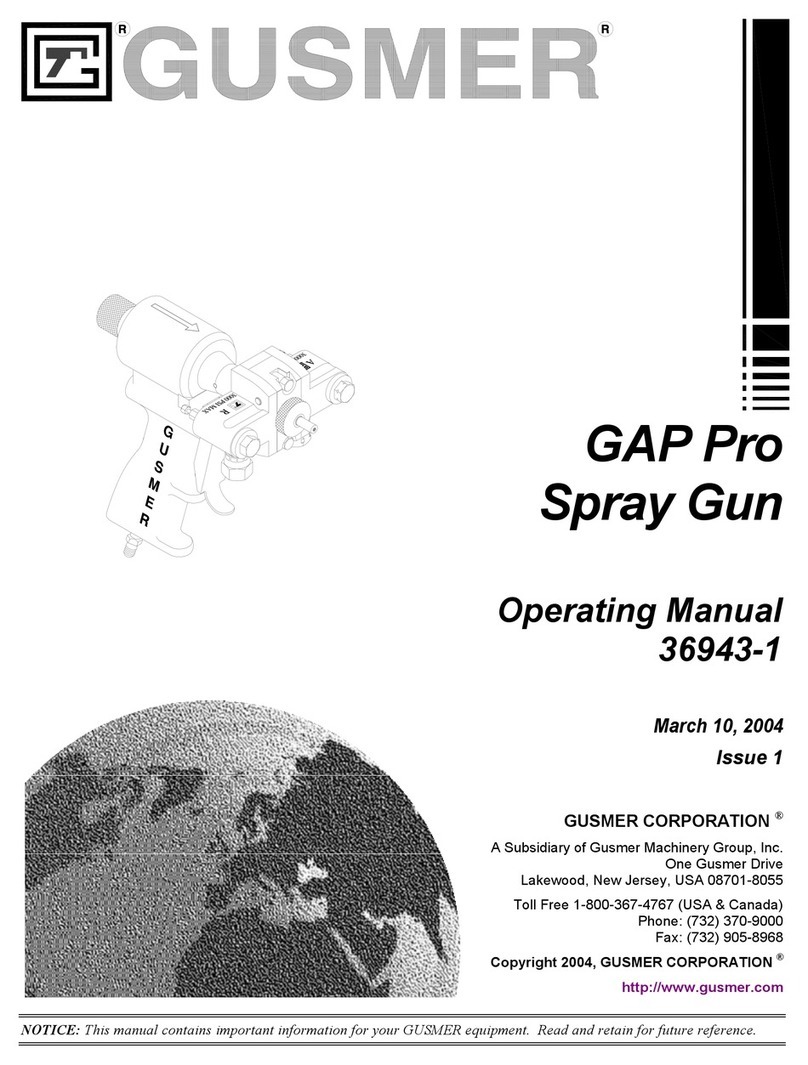
GUSMER
GUSMER GAP Pro operating manual

MaxiMist
MaxiMist SprayMate TNT HVLP ST610EU Instruction manual and users guide

WAGNER
WAGNER 558019 operating manual

WERKU
WERKU WK500480 Original instructions
